Asian Textile Studies
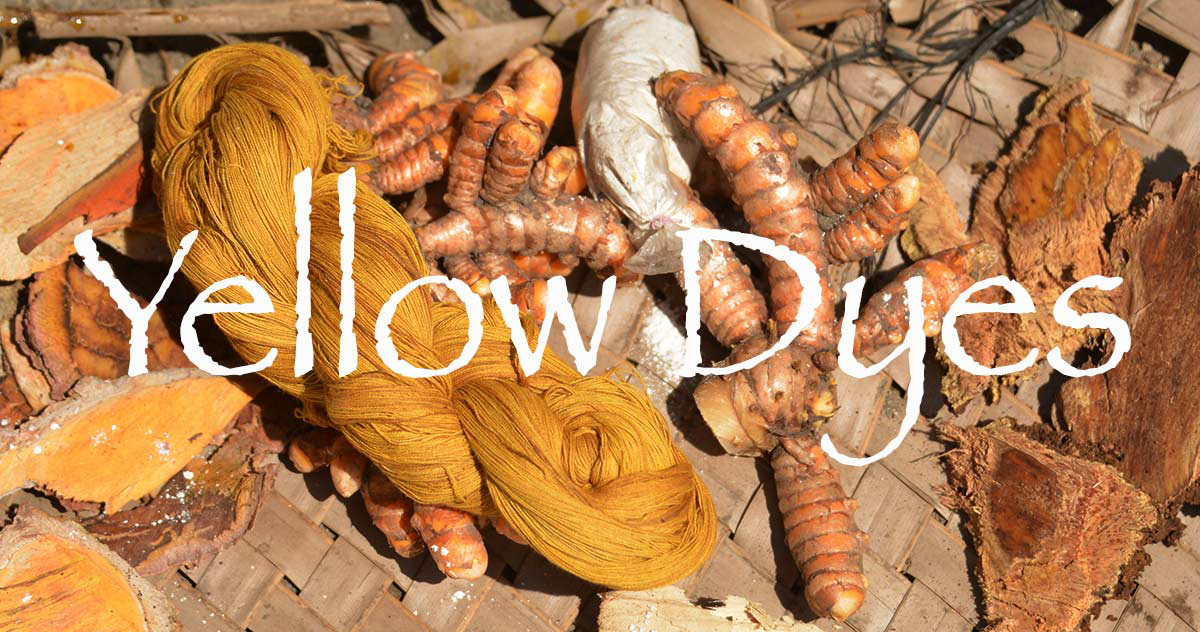
Contents
Natural Yellow Dyes
The Yellow Flavonoid Dyes
The Yellow Carotenoid Dyes
The Yellow Curcuminoid Dyes
Turmeric or Kunyit
Jackfruit Wood and Bark
Mango Leaf and Bark
Cockspur Thorn or Kayu Kuning
Safflower or Kasumba
Laban Bark
Prahout
Gamboge
Bibliography of Yellow Dyes
Natural Yellow Dyes
Yellow is one of the most common colours found in nature and natural yellow pigments abound - yet yellow is one the most difficult colours to produce in the form of a colourfast and wash-fast natural dye.
Throughout most of the early historical period, wild mignonette - known as weld or dyer’s rocket (Reseda luteola) - seems to have been the most common yellow dye used in Western Europe (Liles 1990, 33). A survey of 500 textile samples drawn from museums in Europe and America, dating from the period 1500 to 1850, found that of the yellows, 80% were dyed with weld (Prance and Nesbitt 2012, 308).

Weld (Reseda luteola) only grows in temperate climates
(Wikiwand Creative Commons)
By the early 1500s European dyers were using many other yellow dyes, such as dyer’s broom (Genista tinctoria), also known as dyer’s greenweed; young fustic (Conitus coggygria), also known as sumac or smoke tree; dyer’s buckthorn (Rhamnus saxatilis); flax-leafed daphne (Daphne gnidium); and sawwort (Serratula tinctoria), although weld remained the most lightfast and was therefore preferred by professional dyers (Keeler 2014). After the Spanish settled in parts of the Caribbean and Central America they discovered that a bright yellow dye tinged with orange could be extracted from the wood of Maclura tinctoria (formerly Morus tinctoria or Chlorophora tinctoria), a large tropical tree that grows in lowland forests (Adrosko 2012, 32).
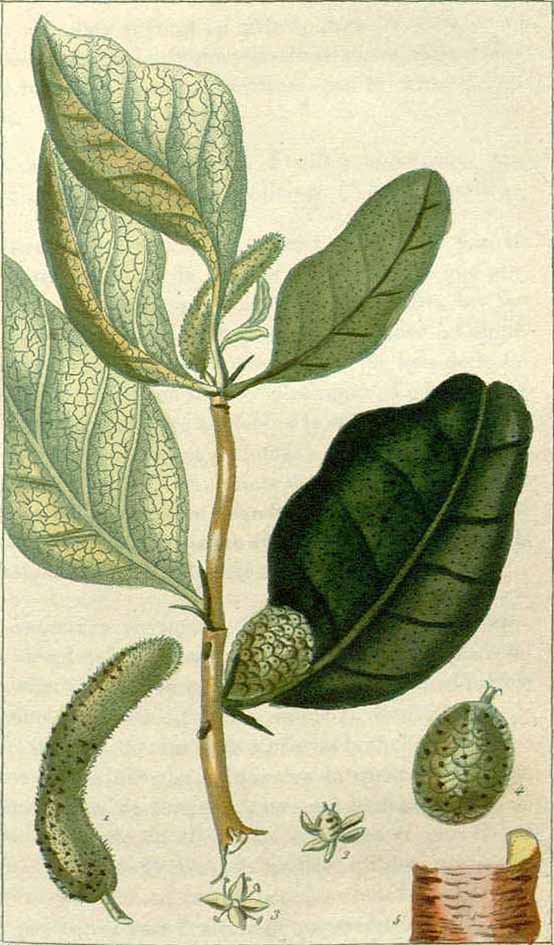
Dyer's mulberry or old fustic, Maclura tinctoria
(J. T. Desccourtliz 1828, vol. 6, plate 431)
By the 1800s thousands of tons a year were being shipped to Europe and the USA under the name of dyer’s mulberry or old fustic, primarily for the dyeing of wool and much later khaki (Keeler 2014). Weld was eventually superseded in the second half of the nineteenth century by the stronger and much cheaper quercitron, first extracted from the American black oak (Quercus velutina) by Edward Bancroft in about 1775 (Liles 1990, 33). Despite being less lightfast, natural quercitron remained the leading commercial yellow dye until the adoption of synthetic alternatives in the 1920s.
In India they used a multitude of yellow dyes, far too long to mention, with different dyeing recipes used in different regions (Mohanty, Chandramouli and Naik 1987, 21-25). One of the oldest and most widespread yellow dyes was obtained from the root of haldi (turmeric, Curcuma longa), which could be lightened by the addition of jetha and lime juice or darkened by adding an alkaline solution of alum. Other important yellow dyes included those prepared from the flowers of harsinger (night jasmine, Nyctanthes arbor-tristis); tesu, palasha or kesuda (bastard teak, Butea frondosa); and tun or toon (red cedar, Cedrela toona); as well as the dried rind of naspal (pomegranate, Punica granatum); the seeds of latkam or latkan (annatto, Bixa orellana); the sawdust of kanthal (jackfruit, Artocarpus integrifola); and the bark of lodh (Symplocos racemosa) (M'Cann 1883; Mohanty, Chandramouli and Naik 1987, 21-25). Sometimes these ingredients were mixed into a cocktail. In Delhi, Rohtak and Gujranwala the most exclusive yellow dye was obtained from the dried flowers of zafron (saffron, Crocus sativus), fixed with citrus juice.
In Southeast Asia a similar wide range of yellow dyes was prepared, which varied across the different regions and climate zones. Many of them are now forgotten. For example, in the Chittagong Hills of Burma yellow was extracted from the roots of various unnamed trees and shrubs (Barbe 1845, 386). One important source of yellow in lowland Burma was the heartwood of jackfruit, which was once widely used to dye the robes of monks throughout Buddhist Southeast Asia (Fraser Lu 1988, 30). Jackfruit is included in an inventory of yellow dyes used in Shan State in the late nineteenth century along with the barks of tauksha (Vitrex glabrata), thingan (Hopea odorata), tayetngapyaung, taungthale (Garcinia cowa) and coconut, as well as the roots of nyaw (Morinda coreia, formerly M. exserta), the latter sometimes mixed with turmeric (Scott and Hardiman 1900, 382-383). However in the highlands of Burma yellow seems to have been used sparingly, although some Naga groups did use the barks, stems and blossoms of various trees growing in the jungle (Howard 2005, 27).
In northern Thailand yellow was obtained from the leaves of makham thai (tamarind, Tamarindus indica); the sap of rong (mangosteen, Garcinia mangostana); the heartwoods of jackfruit (Artocarpus integrifola) and kae lae (cockspur thorn, Cudriana javanensis); the seedpods of ma tum (the bael tree, Aegle marmelos); the bark of nom meo (Rauwenhoffia siamensis); the flowers of night jasmine (Nyctanthes arbor-tristis); and the root of khamin chan or turmeric (Conway 2002, 181). Other yellow dyes identified from elsewhere in Thailand are the flowers of faai (cotton); the leaves of mueat chee or mueat ae (Memecylon scutellatum), sometimes mordanted with Symplocos; the leaves of kluai bua (lotus banana, Musa rosea); the fruit skin of ma kruut (Kaffir lime, Citrus hystrix); the leaves and bark of mamuang (small mango, Mangifera caloneura); soi thong (Goldenrod, Solidago polyglossa); and two additional dyewoods: saak (breadfruit, Artocarpus altilis) and kra thin narong (Australian wattle tree, Acacia auriculata) (Moeyes, Srikanthimarak and Morimoto in Gittinger and Lefferts 1992, 243-248). The province of Ligor, in Southern Thailand, was an important producer of cockspur thorn, known locally as kleh. Because kleh produced a relatively fast yellow when mordanted with alum it was exported to Coromandel where it was valued by local textile printers for its brilliant, fixed colour (Asiatic Journal, April 1825, 425).
In Laos Patricia Cheesman claims that yellow and orange were obtained from the leaves of either bai keua, bai kae or kam med, respectively Cudriana cambodiana, now Maclura cochinchinensis or cockspur thorn, Cudriana poianea and the rosewood Dalbergia stipulacea (Cheesman 1988, 59). It is more likely that dyers used the wood and bark of these trees, not their leaves. Yellow was also obtained from the flowers of kam nong (safflower, Carthamus tinctorius); the seedpods of mak pin (the bael tree, Aegle marmelos); the wood of mai ma na (black myrobalan, Terminaria chebula); and the rhizomes of kamin or turmeric (Cheesman 1988, 59).
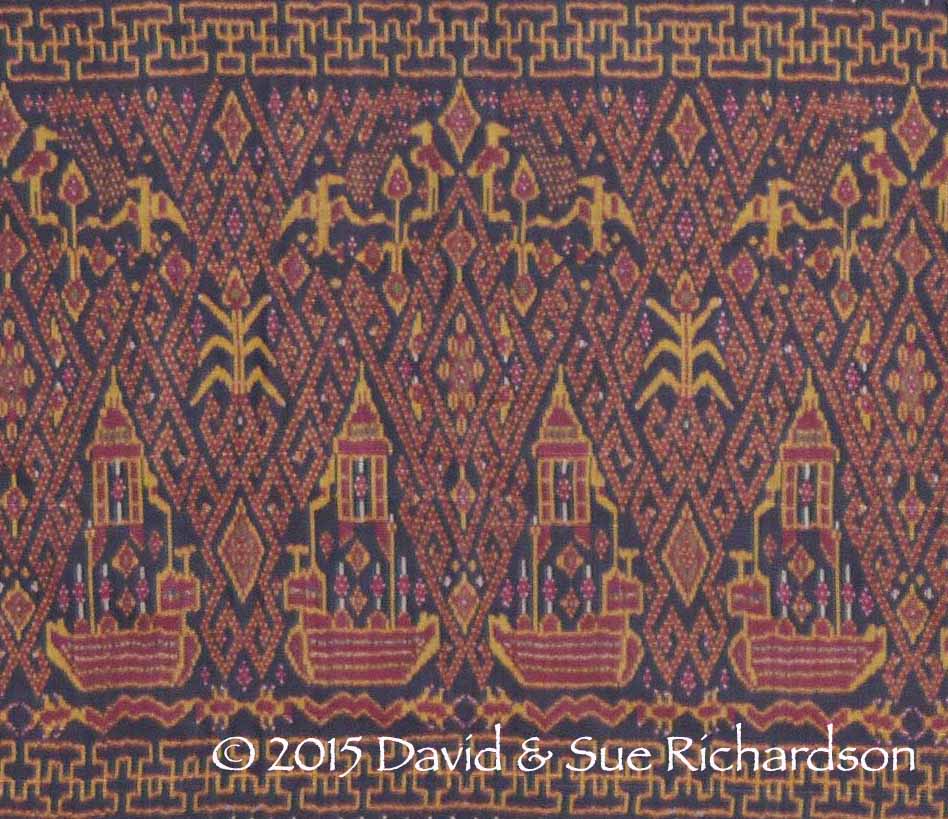
Extensive yellow detailing in a Cambodian silk ship cloth
In Cambodia yellow was obtained from a wide variety of tree barks. Dark yellow was made from the bark of the prahoat or prahout tree while light yellow dye was made from the bark of the banyan tree, the jackfruit tree, the chong reak tree, the dok po tree, the sangkai tree, the French tamarind tree, and the an jay tree (Narin 2003, 210).
In the Indonesian archipelago yellow dyes were not so varied, but still differed by region. The only early survey of yellow dyes was undertaken by Jasper and Pirngadie and was rather patchy in its coverage. They found yellow was obtained from the flowers of kembang poeloe (safflower, Carthamus tinctorius); the leaves of teroeng (aubergine, Solanum melongena); the roots of a vine called balaongbeamolag or pakoenji; the bark of the laban tree (kayu laban, Vitex pubescens); the heartwood of jackfruit (Artocarpus heterophyllus); the heartwood of cockspur thorn (Maclura cochinchinensis, formerly Cudrania javanensis), known in different regions as either tegerang or kayu kuning and occasionally mixed with the leaves of ketapang utang (Terminalia catappa); and finally the rhizome of turmeric (Curcuma longa), known as kunyit, kunir or oelin, sometimes mixed with the juice of either lemon or sugarcane (Jasper and Pirngadie 1912, 61-73).
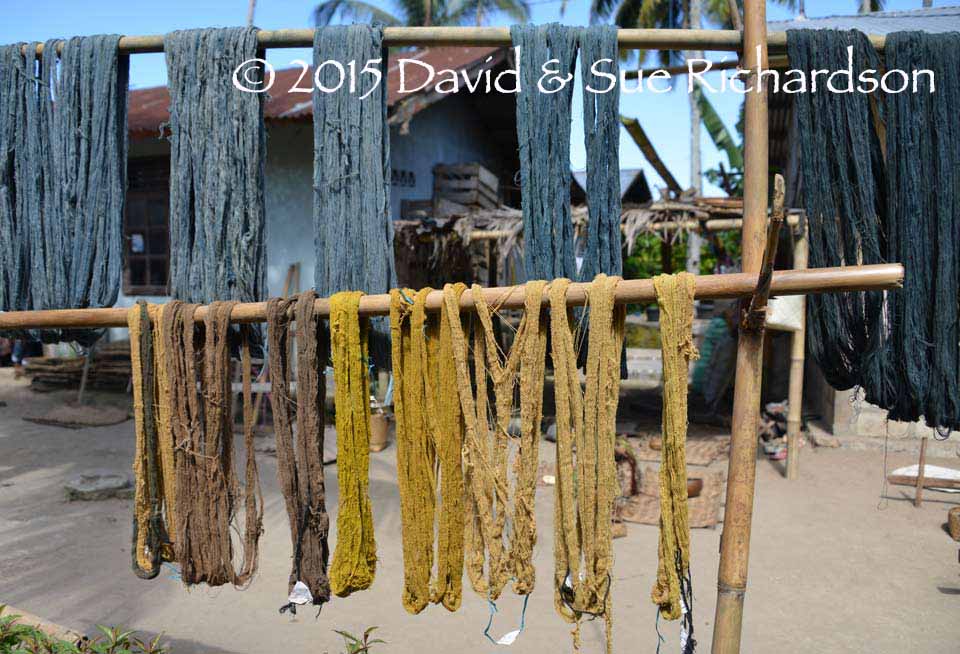
Cotton dyed in different shades of yellow and brown, Flores
Many of these dyes have probably been used since antiquity. The early Austronesians seem to have been well aware of the most important trees and plants that provided a source of yellow dye. Linguists believe that the words for turmeric (kunij), jackfruit (nanka), breadfruit (kulur), and mango (wai) were all present in the Proto-Malayo-Polynesian lexicon (Blust 1988, 61).
Today the most important yellow dyes still used in Indonesia are turmeric, cockspur thorn, jackfruit and mango. Of these, turmeric gives the strongest yellow but is the least lightfast and wash-fast.
Unfortunately even the best yellow natural dyes are unstable in light. Of great concern to museums, one study found that yellow natural dyes would be completely destroyed after fifty years of permanent exhibition in even the dimmest tolerable conditions (Padfield and Landi 1966, 191). This is one of the reasons why many old textiles appear predominantly brown – they have lost the vitality of their youth.
In nature, yellow pigments mainly occur in the form of flavonoids, carotenoids and curcuminoids. A few others are classified as either xanthones or alkaloids.
Return to Top
The Yellow Flavonoid Dyes
About 90% of the yellow natural dyes are flavonoids (Samanta and Konar 2011, 32). The word flavonoid is derived from flavus, the Latin for yellow. Flavonoids are strong absorbers of blue and UV light, which is why they appear yellow. Consequently UV-Vis spectroscopy is a useful tool for their structural analysis.

Underlying chemical structure of a flavonoid, where R1 and R2 are different or identical functional groups

The structure of quercetin
Within plants flavonoids do not exist in their free form but are bound to sugars. Natural flavonoid glycosides are generally water-soluble and can therefore be easily extracted from plant tissues (Britton 1983, 107). In the dye bath the flavonoid glucoside is first hydrolysed into its parent aglycone – in other words the glycoside sugar is removed (Columbini and Modugno 2009, 22).
However to become an effective dye the flavonoid is best combined with a metallic mordant to form one or several flavonoid metal complexes. The latter are still water soluble and are more reactive than the flavonoid itself, so form a stronger bond with the surface of the fibre. All of the flavonoids are therefore adjective dyes which require a metal mordant. Fortunately flavonoids form complexes with a wide range of metal ions such as aluminium, copper, iron, chrome, and tin. The process is called chelation, meaning that it involves the formation of two or more chemical bonds.
The key active flavonoid sites involved in this bonding appear to be the carbonyl group, C=O, also known as a ketone, and the adjacent phenolic group, C-OH (Columbini and Modugno 2009, 22). However more recent studies on a range of flavonoids now indicate that there are three potential coordination sites at which a metal ion can bind:

Potential coordination sites (Kasprazak, Erxleben and Ochocki 2015)
The chelation of a flavonoid with a metal ion does not necessarily result in just one single metal complex structure. One study has used tandem mass spectrometry to look at rutin metal complexes formed with four different metal ions. It has identified two potential structures:

Proposed structure of rutin-copper complexes (Bai, Song, Chen, Xing, Liu and Liu 2004)
Thus a flavonoid-metal complex can be formed from one, two, three or possibly more flavonoid molecules. To date over forty flavonoid-metal complexes have been studied (Symonowicz and Kolanek 2012).
Chemically the flavonoids can be subdivided into flavones, flavonols, isoflavones, flavanones, chalcones, and aurones, the latter named after aurum, the Latin for gold (Freeman and Peters 2000, 431).

Classification of the flavonoids (Püntener and Schlesinger 2000, 431)
- Flavones have a double bond in the central heterocyclic ring. Roughly 100 flavone dyes have been identified, of which yellow luteolin is the most well- known. It is the active ingredient of weld, dyer’s broom or greenweed, and sawwort. Other yellow flavones include artocarpin (from jackfruit), apigenin and fisetin.
- Isoflavones differ from flavones because the location of the outer aromatic ring (on the right) migrates from carbon-2 to carbon-3 (Preedy 2012, 17). Examples include yellow genistein, pale yellow daidzein, pale yellow luteone and off-white to yellow puerarin.
- Flavonols have a hydroxyl group at carbon-3, between the ketone and the outer ring. They include the yellow pigments morin (from kayu kuning, jackfruit and old fustic), quercetin and kaempferol.
- Flavanones have the flavone backbone without the double bond in the central ring. They include off-white to pale yellow hesperidin from lemon and orange peel, cream-coloured naringin from grapefruit peel, and yellow naringenin (Ikan 2013, 9 and 14). The latter is related to yellow carthamidin and its orange-red glucoside carthamin, which are both found in safflower.
- Neoflavanoids have the second benzene ring located at carbon-4. Examples include yellow berberine from barberry and mahonia, as well as red brasilein from brazilwood and black haematein from logwood.
- Chalcones are open chain analogues of flavonoids, lacking the central heterocyclic ring. They can be easily converted into aurones, either chemically or enzymatically. Many turn red on contact with alkali. Examples include yellow butein and marein, and orange-yellow okanin.
- Aurones are the smallest group in the flavonoid family (Anderson and Jordheim 2010, 583). The most well=known is bright yellow aureusidin extracted from Antirrhinum snapdragon (Ono et al 2006).
Because the basic flavonoid chromophore is susceptible to photochemical attack all flavonoids are degraded by photo oxidation, which decomposes them into quinines and other simpler components. Consequently flavonoid yellows turn dull brown over time (Crews 1982).
Although the majority of yellow natural dye flavonoids are chemically similar, small structural differences bring about important changes in their light-fastness. Of all the flavonoids, luteolin - found in weld, dyer’s broom and sawwort - is the most lightfast, whereas quercetin is the least lightfast and will fade within days or a few weeks in sunlight (Böhmer 2002, 129). Unfortunately quercetin happens to be the most common yellow dyestuff, being found widely in the plant kingdom in the form of the glucoside quercitrin.
Incidentally, not all flavonoids are yellow. The structurally similar anthocyanins, which are mainly blue and purple, are also members of the flavonoid family.
Return to Top
The Yellow Carotenoid Dyes
The carotenoids are one of the most abundant groups of pigments found in nature, with at least 750 identified so far(Briton, Liaaen-Jensen and Pfander 2004, 5: Landrum 2009, 114). They occur in bacteria, algae, leaves, flowers, fruits, and roots and are named after β-carotene, which was isolated from carrots by Wackenroder in 1831 (Cooper and Nicola 2014, 125).
Carotenoids are methylated polyenes, linear long-chain molecules which in many cases have ring structures at the ends. They contain varying numbers of conjugated carbon double bonds with delocalised π-electrons. They embrace a huge variety of chemical structures and can be divided into carotenes, hydrocarbons containing only carbon and hydrogen, and xanthophylls (from the Greek xanthos for yellow and phyllon for leaf), made up of carbon, hydrogen and oxygen.
Carotenoid pigments are widely used in the food industry – examples include red β-carotene, yellow-brown lutein found in green leafy vegetables and red lycopene from tomatoes. Yet only a few carotenoids make suitable textile dyes. These too are mainly bright yellow, orange or yellowish-red due to their absorption maxima in the blue region. The most important are bixin and its water soluble form norbixin, obtained from annatto, and crocin, obtained from saffron, harsinghar, and Indian mahogany. They are both xanthophylls.

Structure of bixin with its four methyl groups
Annatto is a direct dye extracted from the outer layer of the red seeds found in the hairy seedpods of the tropical evergreen bush achiote (Bixa orellana) endemic to Central and South America. In the past it was imported into Europe and used for dyeing silk and cotton. It could produce a number of tones, ranging from yellow to orange and red. In the late 1700s it was introduced into India for commercial production (Prance and Nesbitt 2012, 344). However it only reached the Philippines in the 1930s (Tanchico and West 1937, 429). We have found limited evidence that it has been used in the past as a very minor dye in India, Thailand, Laos, Cambodia, Vietnam, Sarawak and the Philippines and possibly also in Burma. In Cambodia annatto was used to produce a dark yellow colour for silk. The annatto grains were purchased in the market and were soaked and rubbed in potash water. After immersion in the dye, the silk was boiled in prahout water for fifteen minutes (Sokny, Ratha and Vannak 2007, 23). In Indonesia annatto was used as an orange dye for silk in Jambi, Sumatra, where it was known as kasoembo-keling (Kerlogue 1990, 76-77).
Night jasmine was widely used as a yellow dye source in India and especially Bengal. It was known in Hindi as harsinghar. It was apparently used to dye the orange robes of Buddhist monks (Meshram, Rangari, Kshirsagar, Gajbhiye, Trivedi and Sahane 2012). Night jasmine was also an important dye in Thailand. It grows throughout the Indo-Malaysian region from Nepal to Indonesia. It was used medicinally in Malaysia and Java (Bansal, Suri and Grover 2015). To date we can find no indication that it was used as a dye source in Indonesia.
The Yellow Curcuminoid Dyes
The curcuminoids are mainly found in nature in the rhizomes of plants belonging to the Curcuma turmeric genus, which contains well over 100 species. In practice the most important dye source is true turmeric, Curcuma longa, because it contains the highest concentration of curcuminoid pigments.
Chemically the curcuminoids are classified as diarylheptanoids, having a pair of aromatic rings linked by a seven-carbon chain. Some 19 diarylheptanoids have been identified in turmeric (Pintea 2007,330). They are fairly insoluble in water or acidic solution, but do dissolve in alkalis and organic solvents. However, alkalis rapidly hydrolise them into feruloyl methane, ferulic acid, vanillin and other degradation products - the stronger the alakali the faster the decomposition (Pintea 2007, 331). Because of this, curcuminoid dyes can only be effectively used in either neutral or acidic conditions, within which they remain virtually insoluble. This lack of solubility does not seem to inhibit their effectiveness, however, possibly because the pulverised rhyzomes form a colloidal suspension in water and they act as direct dyes without any need for a mordant. Indeed they can also be used as dyes in the dry state.
Curcuminoid solutions show strong light absorption in the ultraviolet to light-blue parts of the spectrum (300 to 500nm), making them appear yellow to orange. Because curcumin extract contains a cocktail of curcuminoids, it has an extended absorption band. Curcuminoids exhibit fluorescence under ultraviolet light.
Turmeric or Kunyit
True turmeric (Curcuma longa, also known as Curcuma domestica and Curcuma tinctoria), is an erect perennial herb belonging to the Zingiberaceae or ginger family. The name Curcuma is derived from the Arabic word kurkum, which originally meant saffron but is now used exclusively for turmeric (Mortensen 2006, 1483). Some 133 species of Curcuma have been identified, 41 of which are found in India (Prasad and Agarwal 2011, 266). At least 10 of these are indigenous to the Indian subcontinent. Many species are also found in Burma and Thailand (Prabhakaran Nair 2013, 7). In addition to C. longa, six other species have been found to contain curcuminoid colouring agents (Aggarwal et al 2007, 4).
Turmeric is an erect perennial herb, but also has annual and in some cases biennial varieties. It grows to a height of about one to one and a half metres and has long lanceolate leaves and white, pink or purplish flowers. While some species of Curcuma produce seed, C. longa does not and propagates from rootstock instead (Prabhakaran Nair 2013, 18-19). It forms rhizomes (underground stems) composed of an ellipsoid primary tuber and a haphazard arrangement of finger-like secondary tubers. It requires tropical temperatures in the range of 20 to 30°C, along with a considerable amount of rainfall.

Curcuma longa (Unterhaltungen aus der Naturgeschichte, Wilhelm, 1816)
Turmeric is thought to have originated in southern Asia as wild turmeric (Curcuma aromatica), probably the Indo-Malaysia region where it was domesticated and interbred with other Curcuma species (Jansen and Cardon 2005, 68). Its early spread may have been related to the Hindu religion. According to Marco Polo, it reached China around 700 AD (Ridley 1912). It was later spread into Europe by Arab traders (Prabhakaran Nair 2013, 2). Today it is widely cultivated throughout the tropics, especially in India and Southeast Asia. It does not occur in a true wild state, although it has become naturalised in certain regions.
In Medieval Europe it was known as Indian saffron but in India it is known by Hindus as haldi and by Tamils as manjal. In Sanskrit, turmeric has at least 53 different names (Prasad and Aggarwal 2011, 264).
In Malaysia and Indonesia it is known widely as kunyit, but is also has a number of other localised names:
Location |
Name |
Location |
Name |
Aceh |
kunyét |
Manggarai |
wunis/kunis |
Aceh Gayo |
kuning |
Ngada |
wuné |
Sumatra Batak |
hunik/huning |
Ende |
kuné |
|
|
Lamalera |
kuma |
Minangkabau |
kunai/kunik/kunyik |
Ambon |
unin/kuminu/kunino |
Lampung |
kunyir |
Seram |
unin/uniné/kunin |
Minihasa |
kuniq/kunir |
Buru |
uni/koné/konik |
North Sulawesi |
kuni/kunidi |
Ternate |
gorachi |
S Sulawesi (Bugis) |
unyi/unyiq |
Maluku |
kuniné |
Sunda |
konéng |
West Sumba |
kunita |
Java |
kunir |
Savu |
kewunyi |
Madura |
konyék/konyet |
Roti |
unik/hunik/kunik |
Lombok |
kunyiq |
Timor Tetum |
kunir |
Bima, Sumbawa |
huni |
Papua |
rame |
(Crawfurd 1820, 462; Muhlisah 2007, 37; Kikusawa and Reid 2007, 345).
Linguists believe that the term kunyit derives from the Proto-Malayo-Polynesian word *kunij, meaning both turmeric and yellow (Kikusawa and Reid 2007, 343). The latter authors apply linguistic gymnastics to conclude that the word initially referred to both the colour yellow and to yellow dye. The implication is that turmeric was being used as a yellow dye by the first Austronesian cultures that settled in the Indonesian archipelago.
Along with fustic, turmeric produces one of the brightest, richest yellows of all the natural yellow dyes (Cox Crews 1982, 48). It is a substantive (direct) dye that can dye cotton without the use of a mordant, producing a vivid and deep yellow-orange. Its disadvantage is that it is the least lightfast of all ofthe yellow dyes, fading faster by a factor of four. Despite this huge disadvantage, the European dye houses valued its colour so highly that they used it widely throughout the eighteenth and nineteenth centuries.
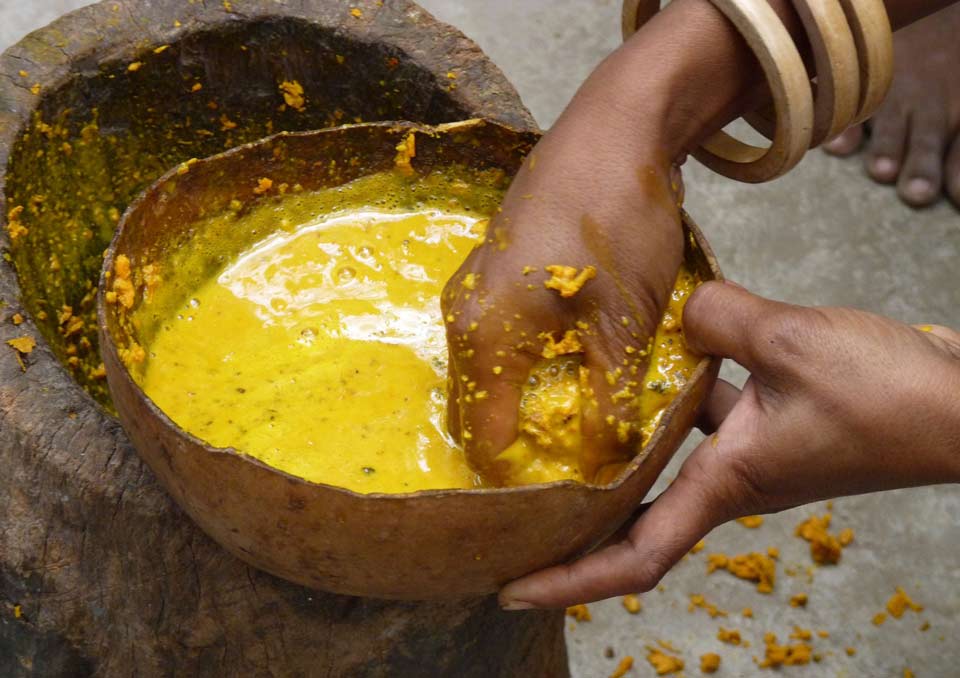
Squeezing out pulped turmeric at Watublapi, the ‘Iwang Geté highlands, Sikka
(Image courtesy of Northrop and Johnson Yacht Charters)
The simplest method for dyeing with turmeric is to chop the tubers and then crush them in a mortar before allowing them to steep in water until the yellow dye has been released (Bühler 1948, 2489). Alternatively the tubers can be washed, peeled and dried and then ground into a powder for future use (Fraser-Lu 1989, 30). Some dyers used a heated dye bath.
Turmeric decomposes and becomes reddish-brown in the presence of alkali (Mellor 1922, 390). It was therefore common to fix the turmeric with acidic lemon or lime juice. For example in Bengal, where turmeric was mainly used by the lower classes, lemon or lime juice was sometimes added to remove the red tint caused by the presence of alkali (M’Cann 1883, 85). In Kolkata they used lemon or lime juice in combination with sajimati (sodium carbonate) to produce a brilliant yellow called basanti rang. Sometimes powdered lime or alum was added to produce a darker shade of yellow (Bühler 1948, 2489). In Bengal alum was considered to make the yellow purer by removing any traces of red (M'Cann 1883, 85). In some parts of Indonesia turmeric-dyed threads were rinsed in citrus or tamarind juice to improve colour fastness (Warming and Gaworski 1981, 71).
Having said this, some dyers in East Sumba deliberately strengthened turmeric by adding a small amount of lime powder (Hambuwali 2016, personal communication).
Turmeric was by far the most widely found yellow dye in India (Crill 1998, 13). It was used from Gujarat to the Coromandel Coast to dye silk patolu, kalamkari, block-printed chintz, and palampore (Watt 1889, 667; Maxwell 1991, 105). In traditional Indian calico-dyeing turmeric was often applied last by hand, especially over indigo, to colour in details such as leaves (Peck and Bogansky 2013, 131). Although it faded on items such as turbans, they were simply washed and re-dyed.
On Borneo the Iban do not seem to have used kunyit as a yellow dye (Blehaut 1994, 64). They used barks and dyewoods instead (Ong 1986, 24). However turmeric was used as an under-dye in the first stage of their morinda (engkudu) dyeing process (Howell 1912; Haddon and Start 1936, 21). It was more widely used as a foodstuff, medicine and a body dye. However other Dayaks used small quantities of kunyit (C. longa) and intamu (an unidentified Curcuma species) (Ling Roth 1896, 35; Agricultural Bulletin of the Straights and Federated Malay States 1906, 233-234). Jasper and Pirngadie also reported that the Dayaks produced yellow from turmeric and either citrus ('djëroek') or lemon juice (1912, 70).
According to Marsden, two types of turmeric were cultivated in Sumatra, one (cooniet mera) used for flavouring and the other (cooniet tummoo) used for dyeing (Marsden 1783, 74). The Batak however only rarely used turmeric, primarily dyeing with just indigo and morinda (Niessen 2009, 433). Some Batak dyers added turmeric (hunik) to their dried morinda powder for producing red (Niessen 2009, 441). Turmeric seems to have been more widely used among the highland Gayo-Alas (Elliot and Brimacombe 1987). In Lampung the distinctive mustard yellow bands in the ceremonial tapis skirts were produced from a dye composed of turmeric, lime (kapur sirih) and tamarind (asam Jawa) (Totton 2009, 42). These additions darkened the yellow. In Bengkulu they produced a yellow from turmeric and the juice of black sugar cane (Jasper and Pirngadie 1912, 67).
On Bali, Stuart-Fox was unclear as to whether turmeric was used as a dye in ancient times (Stuart-Fox 1993, 89). Although not mentioned in the earliest inscriptions, safflower seems to have been the primary yellow dye from the end of the tenth century. G. P. Rouffaer also believed that yellow was obtained from safflower in Indonesia long before the use of turmeric (Bühler 1948, 2489). However in more recent times locally planted turmeric was preferred (Nabholtz-Kartaschoff 2008, 78). Prior to the acceptance of synthetic dyes, yellow was produced on Nusa Penida from turmeric, lemon juice and pineapple leaves (Hauser-Schäublin et al 1991, 99). Max Weber collected the recipe in 1972: one kilogramme of turmeric, one small lime fruit and one pineapple leaf were powdered, added to five times as much water, stirred and sifted. The yarn was dyed in this solution four times over a period of four days (Nabholtz-Kartaschoff 1991, 128). Clearly this dye solution was only weakly acidic.
On Lombok the Sasak used turmeric to dye the stripes in their sacred, coarsely woven white cotton umbaq kombong cloths, given to every young child and subsequently used at ceremonies celebrating important life-cycle events. After dyeing, the cloths were washed in the river to leave them a dull-yellow colour, meant to symbolise greatness and fame (Cederroth 1995, 34 and 42).
On Flores in the Ata Sikka region turmeric was used for producing yellow monochrome warp stripes, as well as orange or green stripes by overdyeing with either morinda or indigo (Lewis 1994, 162). At Doka in the ‘Iwang Geté region they produce a deep mustard yellow from turmeric, mango bark, mengkudu tree bark (not root), jackfruit bark and powdered lime (kapur sireh). Dyers at Nita Kloang in the Krowé region also mix turmeric with mango bark. Meanwhile on Palu’é Island they inserted narrow yellow-orange warp stripes into their textiles, made from a mixture of turmeric, betel pepper, areca nut and lime (Vischer 1994, 262).

Turmeric and bark-dyed cotton at Doka, the ‘Iwang Geté highlands, Sikka
The dyers on Ilé Api use turmeric to make three different shades of yellow. In each case they first wet their cotton yarns before imersing them in the dyebath. They begin by boiling chopped kunyit tubers in water to produce the basic yellow dye mix. They use this unadulterated to dye their cotton a golden mustard yellow. By acidifying the dye with the addition of the juice of several limes to the mix, they can obtaine a bright light yellow. However the addition of alkaline lime powder (kapur) to the kunyit bath produces a darker shade of orange-yellow.
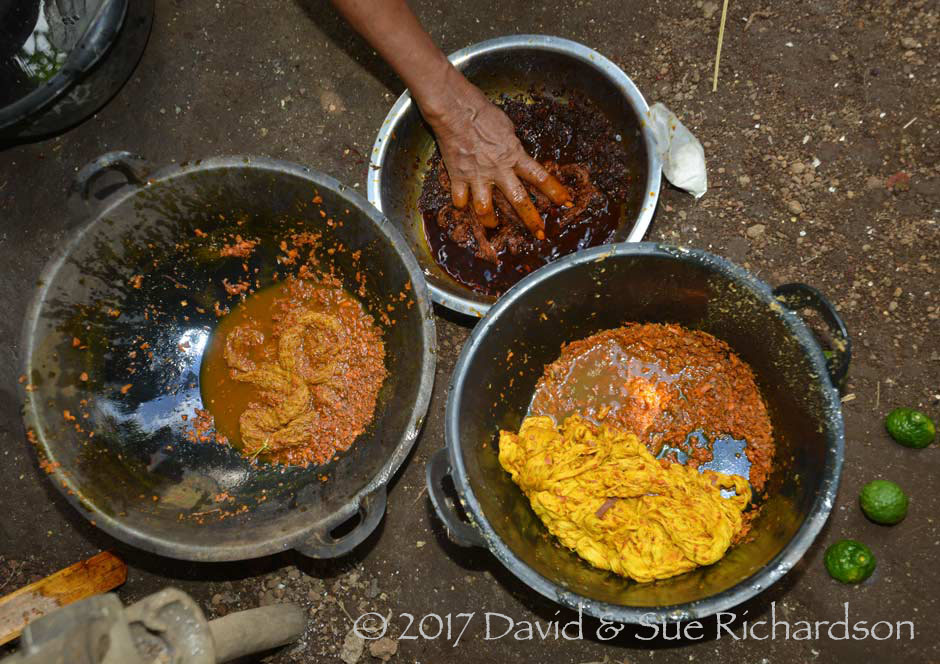
Left: unadulterated turmeric. Above: turmeric with lime powder. Right: turmeric with lime juice.

Mama Mulia holding up three hanks of wet, turmeric-dyed cotton at Bungamuda. Left: pure turmeric; centre: turmeric with lime powder; right: turmeric with lime juice
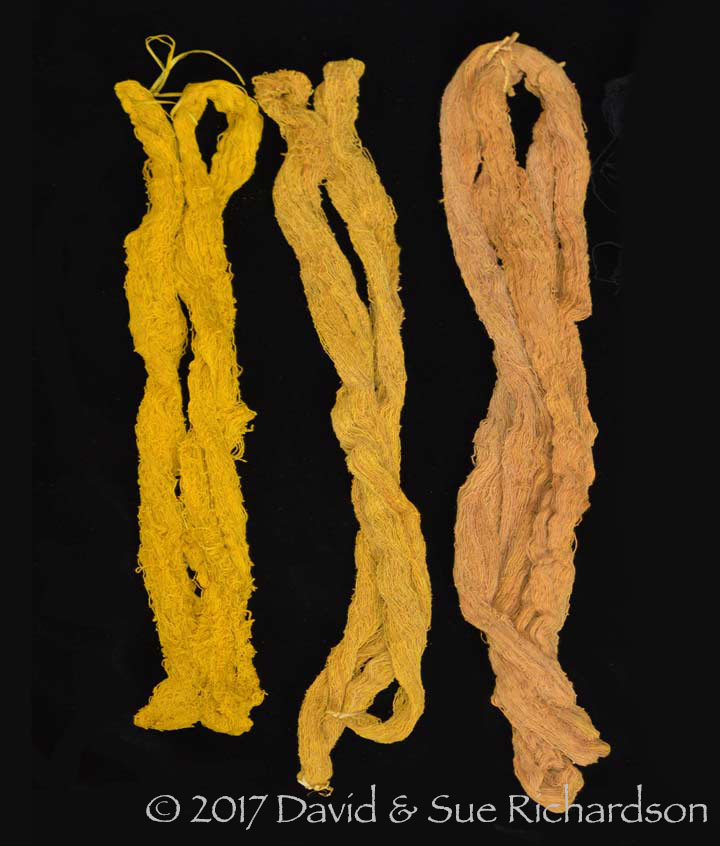
The colour differences become more muted after drying. Left: turmeric with lime juice; centre: pure termeric; right: turmeric with lime powder
Turmeric is also used for the deep mustard-yellow, known as kuma maté, used in warp stripes in bridewealth cloths from Lamalera (Barnes 1989, 31 and 93). Local dyers tell us that they prepare the dye from turmeric, morinda root and lime. Turmeric's lack of light-fastness is less of a problem for adat cloths that are rarely exposed to light.
On Timor the most common natural yellow dye was kayu kuning (Yeager and Jacobson 2002, 65). However some turmeric was used as well. Bühler found that in central Timor dyers immersed their cotton in the turmeric dye bath two or three times, each immersion lasting six hours, allowing it to dry in between (Bühler 1948, 2489). In the Insana region they used turmeric, but employed a dry dyeing technique. Dried tubers were finely ground into a powder into which the yarns were immersed. The yarns were then pounded until they reached the desired colour (Coury 2004, 98). In Biboki they combine turmeric with tamarind leaves (Barrkman 2006, 94). Today the use of turmeric is more widespread (Cunningham et al 2014, 101). At Baun, Amarasi dyers used either turmeric, which they called saffron, or pomegranate rinds to produce yellow (Usif Robert Koroh 2016, personal communication).
On Savu they use turmeric for yellow although this is not a traditional colour (Duggan, private communication). Some local dyers even incorporated turmeric in their indigo recipe (Warming and Gaworski 1981, 68). Yellow is mainly used for dyeing the narrow plain warp stripes in the end sections of women's èi or the side bands of men's hi’i - locally known as the wurumada or 'delicate eyes'.
The majority of East Sumba textiles do not include yellow. In the past yellow was reserved for the nobility, and was always added at a late stage in a textile’s production by means of painting (Nooteboom 1940, 88). Today yellow detailing is added to indigo- and morinda-dyed ikat and to the supplementary warp decoration of pahikung using the ndatta technique, with the dye applied with a coconut fibre brush or toothbrush. However turmeric-based dyes are never applied to high quality textiles because they fade. Dyers prefer to use a mixture of kayu kuning, lime (kapur) and turmeric. Adams noted that ‘curcuma wood’ was sometimes used for dyeing decorative yarns used in lau or the kabakil end bands of hinggis (Adams 1969, 182). Some dyers in East Sumba use kunyit mixed with lime for a red that does not fade.
In the Tanimbar Islands dyers seem to have used only turmeric for yellow in the past, which was known locally as oelin (J. G. F. Riedel, cited by Jasper and Pirngadie 1912, 72).
The yellow colour of turmeric is due to the presence of a group of chemicals called curcuminoids. The active pigment consists of a cocktail containing over 80% of curcumin (diferuloymethane), along with smaller amounts of two structurally similar derivatives - demethoxy curcumin or more precisely p-hydroxyl cinnmoyal-feruloyl methane, which has one less methoxy group than curcumin, and bis-demethoxy curcumin or more precisely p-hydroxyl cinnamoyl methane, which has two less methoxy groups (Sharma 1994, 328). A study of 12 samples of turmeric pigment found the distribution of curcuminoids to be from 71 to 87% curcumin, 11 to 19% demethoxycurcumin, and 2 to 9% bis-demethoxycurcumin (Marsden et al 2003).
These curcuminoids are direct (substantive) dyes that do not require a mordant. It is thought that the dye molecules of curcumin adhere to the cellulose polymer chains of cotton by means of hydrogen bonding, the long axis of curcumin laying parallel to the long axis of the cellulose (Gulrajni and Gupta, 1992).



The structures of curcumin, demethoxycurcumin and bis-demethoxycurcumin
The amount of curcumin in true turmeric has been estimated at 2 to 5% (Aggarwal et al 2007, 2). Of all the Curcuma species, C. longa has the highest curcumin content, followed by wild turmeric, C. aromatica, and then white turmeric, C. zedoraria (Hayakawa, Minaniya, Ito, Yamamoto and Fukida 2001).
Curcumin and its derivatives are phenols belonging to the diaroylmethane group of polyenes. Curcumin readily dissolves in organic solvents such as alcohol, but is only weakly soluble in aqueous solvents. It is relatively stable to weak acids, but increasing acidity turns it scarlet. It is hydrolysed by alkalis, turning first red-brown then violet (De Rosso and Mercadante 2009, 70). Tests have shown that the dyeing of cotton is most effective at neutral pH and a temperature of 75°C.
A laboratory study in Pakistan found that the optimum temperature for extracting the pigment (curcumin) from turmeric rhyzomes was 100°C. However the optimum condition for dyeing was found to be a temperature of 90°C in water containing salt, at a neutral pH of 7 with an immersion time of 60 minutes (Ali 2007, 160). Attempts to dye in alkaline conditions failed, because the curcumin quickly decomposed.
Although yellow is achieved without the use of a mordant, mordants can be added to modify the colour and to improve light-fastness. Alum produces a yellow-brown hue, copper sulphate a yellow-green hue, and tartaric acid a medium to dark yellow-brown hue. Post-mordanting with alum and iron has been shown to produce maximum colour strength and dark yellow shades (Adeel, Bhatti, Kausar and Osman 2012, 89). Tin has been found to produce the largest colour change in turmeric, while alum produces the least (Cox Crews 1982, 49). The best light-fastness is achieved with an iron or copper mordant.
Most artisan dyers use a weakly acidified turmeric dye bath without the addition of heat or a metal mordant.
Curcumin is moderately stable to heat. Its wash-fastness is not particularly good, but this is improved by the addition of a mordant. Its main weakness as a cotton dye is that being sensitive to visible and near UV light it is very fugitive and quickly fades in sunlight, even when applied with a mordant (Bowman and Reagan 1983). One study found that turmeric-dyed wool fades after just 100 flashes from a xenon strobe light (Schaeffer 2001, 80). Another found that cotton dyed with turmeric without a mordant had good saturation and rubbing fastness but poor washing and light fastness. With a mordant, the washing and light fastness improved but the rubbing fastness deteriorated (Umbreen et al 2008).
Return to Top
Jackfruit Wood and Bark
The jackfruit (Artocarpus heterophyllus) and the closely related chempadak (Artocarpus integra) belong to the mulberry or Moraceae family. Chempadak is easily mistaken for jackfruit, but has smaller fruits that are darker yellow.
Both probably originated in India and Malaysia (Janick and Paull 2008, 481). Jackfruit is now widely cultivated in South and Southeast Asia including Bangladesh, Malaysia, Burma, India, Indonesia, Sri Lanka, South China, Thailand and Vietnam. It was probably introduced into the Philippines during the twelfth century and later into America, Africa, and Australia (Pelzar 1948; Haq 2006, 15). Chempadak is distributed in Burma, Thailand, Malaysia, Indonesia and Papua. There are about 50 species of Artocarpus in total, the four most important being Jackfruit, Chempadak, Breadfruit and Marang.
Jackfruit is a long-lived evergreen tree with a straight trunk that grows up to 25 metres tall. It is self-pollinating, both male and female flowers being borne separately on twigs that grow from the trunk and the main branches (known as cauliflory), the female flower being larger than the male flower. The jackfruit is a multiple fruit containing a large number of bulbs, each bulb being a separate fruit. The composite fruit may weigh as much as 30 kg or more. The tree grows in equatorial to subtropical maritime climates in lowland rain forest with an average rainfall of 100 to 240 cm. It will tolerate elevations up to 1600 metres. Growth is moderately rapid in the early years, up to 1.5 m in height per year, but slows as the tree reaches maturity.
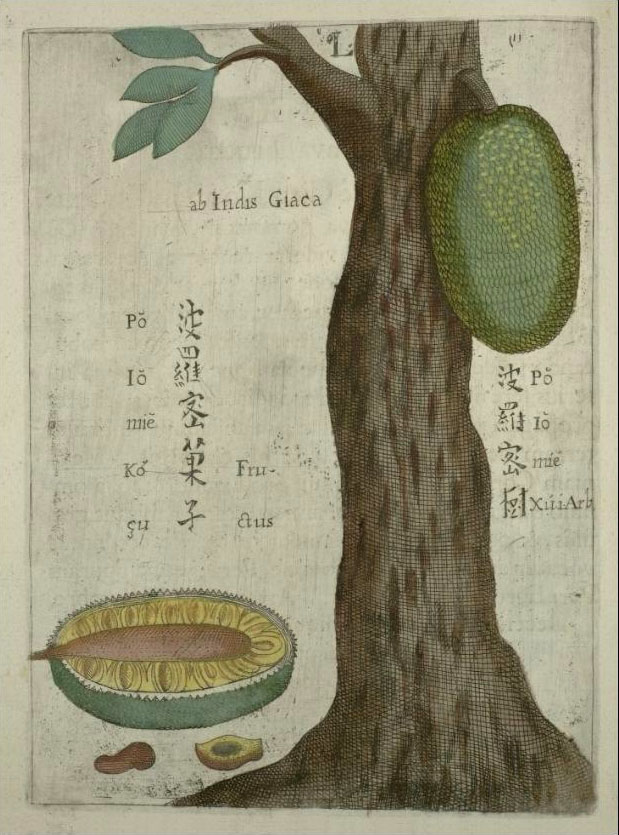
A jackfruit tree in China (Michael Piotr Boym 1656)
Jackfruit occurs throughout the Indonesian archipelago, from Sumatra to Tanimbar, Maluku and Papua. It is cultivated throughout Nusa Tenggara Timur (Pellikila et al 1991). In 2011 it was estimated that there were 763,000 trees growing throughout NTT (NTT in Figures 2012, 233). On Flores it is specifically cultivated in Manggarai and Sikka, and probably in every other regency (Deardon, Neilson and Lansdowne 2002, 57; Metzner 1982, 127). Chempadak is cultivated in Sumatra, the Lingga Islands, Borneo, Sulawesi, West Java, Maluku and Papua (Jansen, 1991).
Because of its quality and deep yellow colour, jackfruit timber was often the preferred choice for royal palaces in Bali and Makassar (Sulawesi) and for temples in Vietnam (Tate 2000).
The sapwood or heartwood of jackfruit produces a relatively stable orange-yellow dye, extracted by boiling wood chips or sawdust in water. Depending on the dyeing conditions, jackfruit wood can produce a wide variety of colours, ranging from muddy yellow, to golden and orange yellow, through to apricot and tan (Fraser-Lu 1988, 30). For example, the addition of an aluminium mordant produces a more intense yellow, while alkali turns it into a dark yellow approaching orange. Some dyers mix jackfruit wood and turmeric with an aluminium mordant. In East Timor one village makes a yellow dye by boiling a mixture of jackfruit bark, mango bark and turmeric (Cunningham et al 2014, 101).
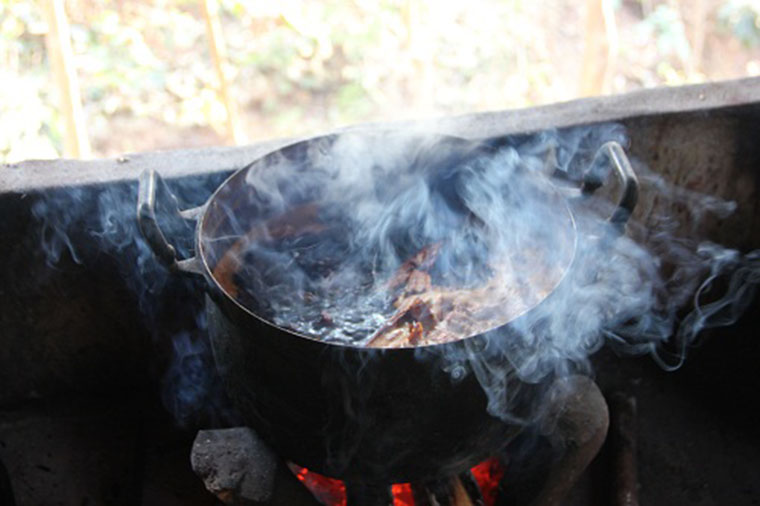
Boiling a pot of jackfruit bark in Luang Prabang, Laos
(Image courtesy of Laura at The Pollen Path)
Jackfruit was used to dye and rewash Buddhist monk’s robes in Sri Lanka, Burma and northeast Thailand (Balfour 1871, 204; Fraser-Lu 1988, 30). The Vinaya Pitaka, the text that regulates the Buddhist monastic community, regulates the clothing of both monks (bhikku) and nuns (bhikkhuni). In the section known as the Mahāvagga, the eighth Khandhaka covers the dress of the bhikkus. Chapter 10 mentions that monk’s robes were at one time badly coloured using (cow)-dung or yellow clay. In response, the Buddha prescribed six generic types of natural dye that could be used instead, namely: roots, tree trunks, barks, leaves, flowers and fruits. He further instructing that the dye should always be boiled (Rhys-Davids and Oldenberg 2012). In chapter 29 the Buddha forbade monks to wear robes that were coloured light yellow, brownish-yellow, dark yellow, blue, crimson or black. In chapter 10 of the tenth Khandhaka he applied the same prohibition to nuns. As such the robes of the earliest Buddhist monks were coloured kasaya, a somewhat unspecific Pali word meaning brownish, dun-coloured or ochre. The word was later used to refer to the robes themselves.
At Minbu in Magwe Divion, Upper Burma, jackfruit was called peih-hnè-bin. Captain Gage found that to make the yellow dye for monk's robes, the jackfruit wood chips were soaked in water and then boiled several times (Gage 1904, 136). After the cloth had been dyed, the jackfruit was fixed with an unidentified vegetable mordant.
In Thailand, monk’s robes were commonly dyed with jackfruit, known as maj kanoon or khanun (Moeyes 1993, 22; Conway 1992, 188). A description of the dyeing process seems somewhat confused, echoing the Buddha's prescription in the Mahāvagga. It claims that the robes were first mordanted in a solution of cow dung, fine red riverbed mud and a selection of plant material including rhizomes, roots, bark, wood, flowers and fruits. Then the heartwood of the jackfruit was chipped or sliced and boiled to produce a dark brown liquid, which was then used to dye the robes the required shade of dull yellow (Suvatabandhu 1964, 45-46; Fraser-Lu 1988, 30).

Robed Buddhist monk at Prasat Preah Vihear, northern Cambodia
In Cambodia two species of jackfruit were used to dye monk’s robes a variety of shades ranging from an earthy yellow to rusty orange to brown. These were cultivated jackfruit, known as khnor (Artocarpus integrifoiia) and wild jackfruit, khnor prei (Artocarpus rigidus). They used the bark and wood of the former and the roots of the latter (Green 2003, 53-54).
In the past jackfruit has been used as a yellow dye throughout the Malay Archipelago. It was used by the Iban who mixed it with an alkali (Fraser-Lu 1988, 31). On Sumatra, Marsden noted that they used the chipped roots of chapada or champadak (Artocarpus integra), sometimes strengthened by the addition of a little turmeric and an alum mordant (1811, 96 and 99). Repeated steepings and dryings were required to obtain a good colour. In Jambi they used the closely related green tampang tree (Artocarpus dadah) to dye cotton batik a shade of yellow (Kerlogue 2004, 128). On Java, Raffles described it as nángka and noted that it was the bark that produced a yellow dye (Raffles 1817, vol.1, 40 and 44). In the past it was mordanted with alum to dye batik (Fraser-Lu 1988, 30). Today jackfruit is only used in the Lesser Sunda Islands by a few groups, such as the Sikka of 'Iwang Geté region and the Amarasi of Baun in West Timor.
Jackfruit wood has a pH of 11 and contains at least 40 different flavonoids, including the yellow colorants morin and artocarpin (Leela 2012, 90-93). A detailed Indian analysis of the pigments found in jackfruit wood identified morin, dihydromorin, cynomacurin, artocarpin, isoartocarpin, cyloartocarpin, artocarpesin, oxydihydroartocarpesin, artocarpetin, norartocarpetin, cycloartinone and artocarpanone (Rama Rao, Varadan and Venkataraman 1973). For the chemistry of morin see Kayu Kuning below.
Mango Leaf and Bark
The mango (Mangifera indica) is an evergreen tree that grows in the tropical rainforests of South and Southeast Asia. It can live for several hundred years and reach a height of 40 metres or more (Mukherjee and Litz 2009, 2). It produces pyramidal inflorescences of pinkish-white pink flowers, which mature into clusters of fruit.
Some 80 species of Mangifera have been identified, the largest number being found in Thailand, Laos, Cambodia, Malaysia, Indonesia and the Philippines. Although it was once thought that the Mangifera originated in India before spreading into Southeast Asia, it is now accepted that its centre of origin lay in Southeast Asia (Mukherjee and Litz 2009, 8). Rumphius (1741) suggested that the mango was introduced into certain Indonesian islands in recent times. However an image of the Buddha below a mango tree carved on Borobodur suggests it was known on Java as early as AD 900-1100.
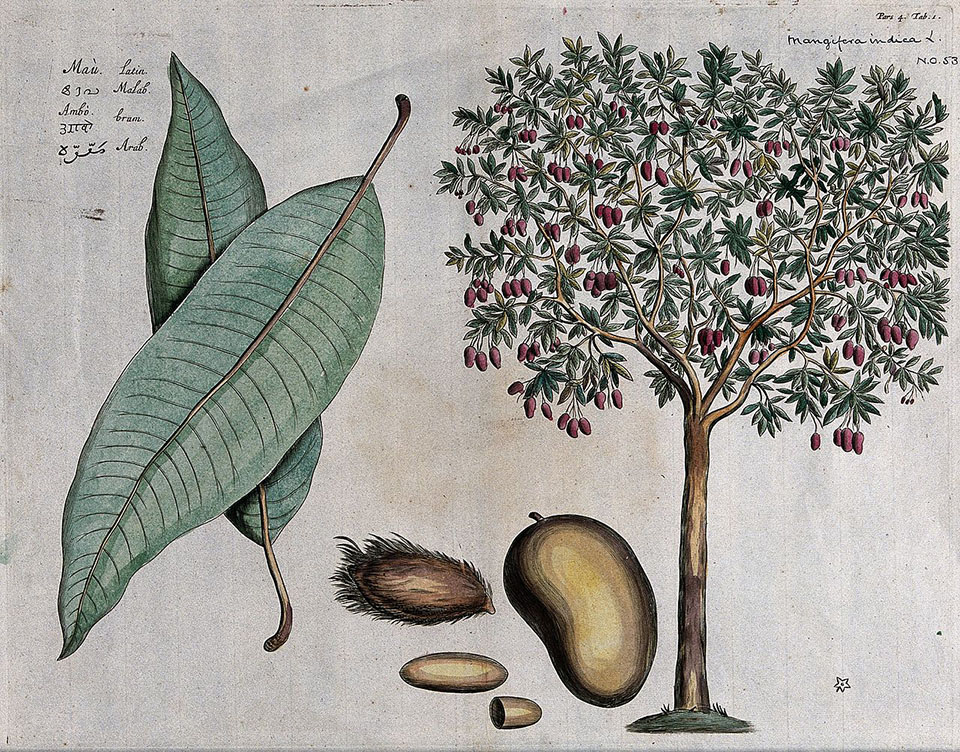
Mangifera indica L. (Hendrik Adriaan van Reede tot Drakestein 1683)
Yellow dyes can be extracted from both the leaves and bark of the mango tree. However mango bark has a higher concentration of mangiferin pigment and tannins than mango leaf (Chochai and Chochai). The dye from the bark is slightly acidic and absorbs light in the blue region, while dye from the leaves is slightly basic and also includes chlorophyll, which absorbs light in the orange and red region. Cotton yarn absorbs the leaf dye better than the bark dye. Mango produces a range of colours ranging from brown, brown-green, grey, and pale brown through to yellow depending on the mordant used.
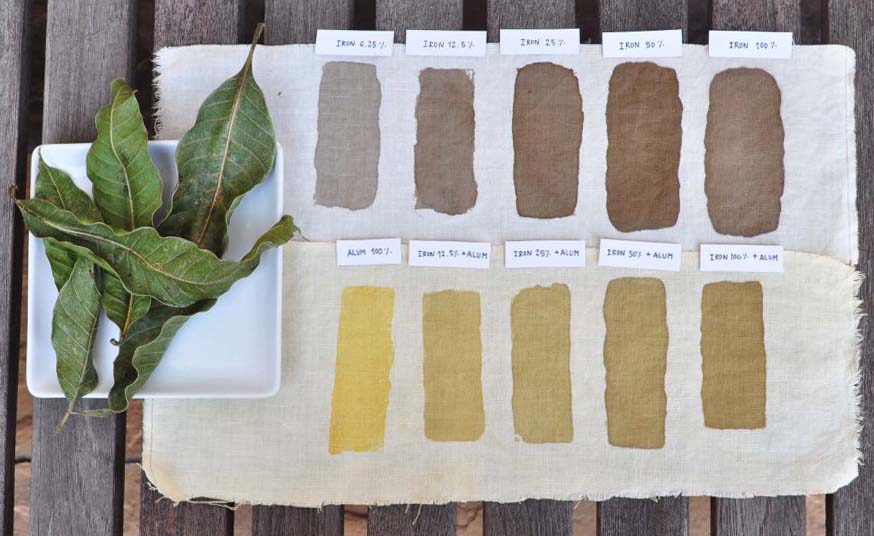
Samples of linen dyed with dried mango leaf and metallic mordants. Alum produces yellow. (Image courtesy of Anne from Slowstitch Studio)
One study of mordanted mango leaf dye found that maximum colour strength on silk was achieved at alkaline pH 10. From neutral pH 7, colour values weakened down to acidic pH 4 (Uddin 2015). It is thought that in alkaline conditions the acidic phenolic groups in mangiferin were neutralised to form soluble salts. Another study found that mango leaf dye on silk had poor wash-fastness. As the concentration of mango leaf dye increased, the wash-fastness of the fabric decreased (Katti, Kaur and Srihari 1996).
Because of its high tannin content (16 to 20%), mango bark was even imported into the UK during the nineteenth century for tanning leather.
In India yellow from mango bark was produced using a mordant of myrobolan flower, sometimes with the addition of alum solution. Myrobolan has a high tannin content and also contains a bright yellow natural dye.
On Flores in the Ata Sikka region, mango bark was sometimes used for producing yellow monochrome warp stripes in ‘utang tubeskirts (Lewis 1994, 162). More durable yellows can be produced using combinations of mango bark and jackfruit wood. At Doka, in the ‘Iwang Geté region, they combine mango bark, jackfruit bark and morinda bark (not root), with turmeric and lime to produce a deep mustard yellow. In the Flores and Solor region another yellow was obtained from a combination of mango bark and morinda, without the addition of oil or loba (Hamilton 1994, 67).
The active ingredient of mango dye is mangiferin, a xanthone C-glycoside. Mangiferin dissolves well in water, so is easily extracted from mango bark or leaves. When dried, mangiferin forms pale yellow needle-shaped crystals.
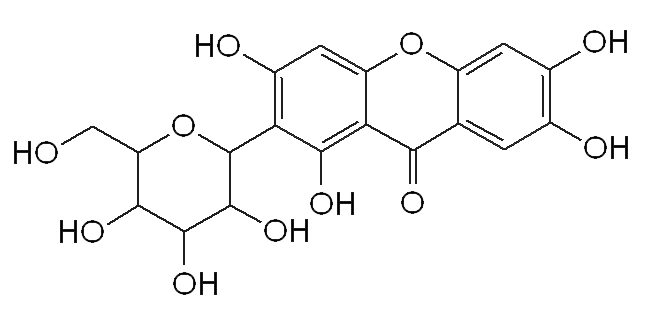
The structure of mangiferin
Mangiferin has been found to be the predominant component (10%) of mango bark extract (Masebo and He 2008). Mango leaf and bark are also rich in polyphenols. Mango leaf has been found to include a mixture of galloyl and hydroxybenzoyl esters as well as epicatechin. Mango bark contains various phenolic acids, phenolic esters and the two flavan-3-ols, catechin and epicatechin.
Cockspur Thorn or Kayu Kuning
Cockspur thorn (Maclura cochinchinensis, also Cudriana cochinchinensis, formerly Cudrania javanensis) is a long-lived woody erect climber or scrambling shrub. It forms rampant untidy clumps, throwing out long arched stems of new growth. Its branches are armed with viscous auxiliary spines up to 2cm long, which are either straight or curved. It has globular mulberry-like syncarp fruits, which ripen from green to yellow, orange or red. It germinates from seed easily and reliably within a few weeks. It is found in lowland forest and thickets in subtropical and dry rainforest. The native range extends from northern India and China, through Malaysia and Indonesia into Australia.
Some 68 species of Maclura have been identified, the majority of which are found in Asia, particularly India, China, Korea and Japan (Vijayan, Tikader et al 2011, 79). They belong to the mulberry or Moraceae family, which also includes jackfruit (Artocarpus heterophyllus) and breadfruit (Artocarpus altilis). Asian Maclura cochinchinensis is related to American Maclura tinctoria, a large dry-forest tree endemic to Central America and the West Indies. Its heartwood was used to produce a bright yellow dye tinged with orange that was known as old fustic or dyer’s mulberry. Mordanted with aluminium or chrome, European dyers used it widely - especially for the dyeing of wool. Osage orange (Maclura pomifera), a second American species, was used by native Indians in the south-central USA to produce a yellow-orange dye (Vijayan, Tikader et al 2011, 87; Austin 2004, 424). The main yellow pigment in all three species is the flavonol morin – see below.
The heartwood and stems of cockspur thorn are used to make a yellow tannin dye with the aid of an aluminium mordant. Wood chips are soaked in water overnight and are then boiled. The dye water is strained off before adding the alum. The fabric is immersed and the mixture boiled to dye the yellow (Hitchcock 1991, 50). On Java some workshops, such as Eliza Van Zuylen’s in Pekalongan, used aluminium-rich jirek bark (Symplocos sp.) as a mordant instead (Raadt-Apell 1981-2, 87).

Cockspur thorn, Maclura cochinchinensis (Francisco Manuel Blanco 1877-83)
Cockspur thorn has been widely used as a dyewood throughout East and Southeast Asia, including China, Burma, Laos, Thailand, Cambodia and Vietnam.
In Thailand cockspur thorn is known as kae kong, kae lae or klae (Quattrocchi 2012, 2367). Another source refers to maj kae (Moeyes 1993, 30). A nineteenth-century report suggested that ‘kleh‘ was only produced in Thailand, in the old southern Kingdom of Ligor, which seems unlikely (Asiatic Journal, April 1825, 425). However this must have been a major producing area because the dyewood was exported to Coromandel, where it was valued for its brilliant and fixed colour by local textile printers. It was claimed to produce a permanent yellow with the aid of an alum mordant. In 1824 a small amount of ‘kaleh’ was shipped from Ligor to Singapore in the form of wooden billets. Despite being confused with old fustic, the dyewood was found to produce a bright yellow after mordanting with tin. It had apparently long been known as a dyewood to both the Thais and the Chinese (Oriental Herald and Colonial Review 1826, 557).
The long-term use of cockspur thorn in China is confirmed by one of the country’s earliest records on dyes, which identifies Maclura cochinchinensis as one of five important dye plants - along with turmeric, oak and Japanese indigo (Pei 2015, 279). However the Chinese may have also used a related species. During both the Ming (1368-1644) and following Qing dynasty a particular shade of yellow was reserved for the Emperor and members of the aristocracy. Known as zhehuang, imperial yellow, its hue differed for each dynasty (Dusenbury and Bier 2004, 181-182). The Ben Cao Gang Mu written by Li Shi-zhen (1518-1593) records that the Ming imperial reddish yellow was made from the wood of the zhe tree (M. tricuspidata, formerly known as Cudriana tricuspidata or Cudriana triloba), a thorny tree that only grows about 5 metres high. Modern reports show that the bark of the zhe or cudrang tree was still being used to produce a yellow dye in recent times (Girard 1968, 648).
In Laos they apparently achieved yellow by using the leaves, rather than the wood, of Cudriana cambodiana, known as bai keua, and Cudriana poianea, known as bai kea (Cheesman 1988, 59). Cudriana cambodiana is a synonym of Maclura cochinchinensis, cockspur thorn, while Cudriana poianea is unidentifiable.
In Cambodia cockspur thorn is known as khlaè or nhoër khlaay; in Vietnam cay bom, dây mo’qua, or mo qua; and in Malaysia kadarang, kederang or kedrae (Quattrocchi 2012, 2367).
However in Indonesia cockspur thorn is known differently as tegeran or tegerang on Java and kayu kuning elsewhere (Lemmens and Soetjipto 1991, 89; Quattrocchi 2012, 2367).
High-quality batik makers on Java, such as at Eliza van Zuylen’s workshop, used tegeranto produce yellow . However its main application was as a key ingredient in the production of brown soga, (McCabe Elliot 1984, 56). Soga was a speciality of workshops in Central Java, especially in Yogyakarta and Surakarta (Fleischmann-Heck and Smend 2006, unnumbered pages). It is made from three dyewoods:
- cockspur thorn or tegeran (c)
- Indian or yellow mangrove, known as tengar or tingi (Ceriops tagal) and
- yellow flame tree or soga (Peltophorum pterocarpum)
in a ratio of 1:2:4 (Lemmens and Soetjipto 1991, 90). See Soga under Brown Dyes.
It has been suggested that the long sharp thorns of tegeran were once used by batik designers to make the tiny pinprick patterns - known as coblosan - in waxed batiks (Heringa 1989, 120).
On Sumbawa, cockspur thorn grew ‘here and there’ on the higher hills and was used to make a dye that produced a dirty yellow (Zollinger 1865, 265).
On Flores kayu kuning was once exported from Manggarai for use in the Java batik industry (Hamilton 1994, 67). At Ile Mandiri and Loba Tobi they obtained a beautiful yellow dye by boiling the wood chips of the 'yellowwood' tree, known locally as kadjo kuma (Vatter 1932, 220).

A bundle of kayu kuning purchased from Waingapu market

Chipped kayu kuning
In East Sumba kayu kuning is known locally as ai iju or ai wingiru and produces a yellow-ochre dye called wingiru or koha (Forth 1981, 15; Forshee 2001, 31). Both of these authors refer to the species of tree as Cudrania spinosa, now Maclura spinosa, rather than Maclura cochinchinensis, leaving some doubt as to whether they use the same or a different variety of Maclura in this region. The resulting dye is used for embellishing hinggis and pahikung using the ndatta painting technique. Sometimes a more golden yellow is achieved by mixing it with kunyit, while different shades of yellowish brown are obtained by adding varying amounts of morinda. One Kambera producer adds tea to the kayu kuning to make a golden yellow. In Rindi they produce an orange-brown by mixing kayu kuning and morinda.
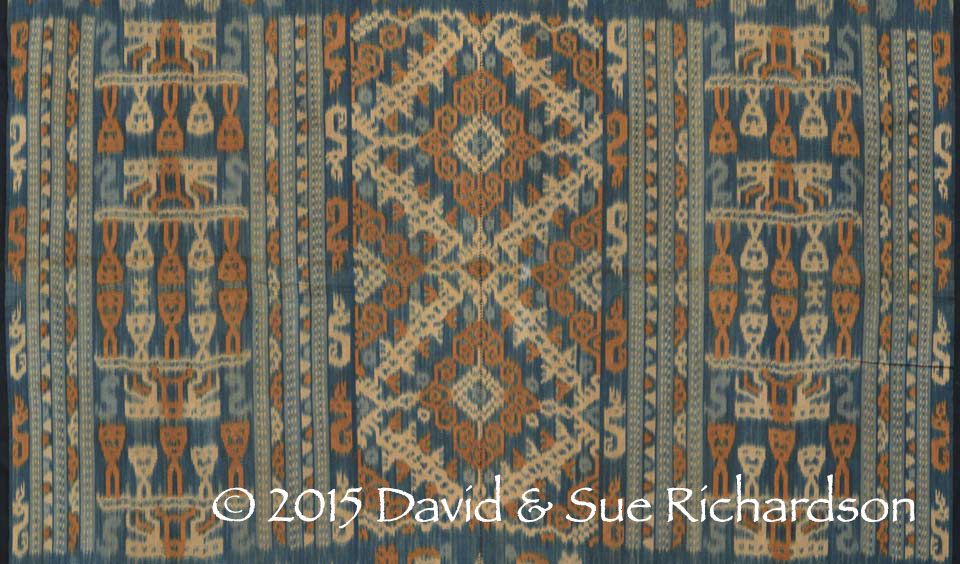
The central panel of a hinggi kawora made in Rindi around 1945. The extensive orange-brown detailing has been achieved by applying kayu kuning darkened with morinda using the ndatta technique
Interestingly a Javanese botanical survey of natural dye plants in the Melolo region of East Sumba identified the species used for making the yellow dye as Maclura cochinchinensis and not Maclura spinosa. The surveyor’s local informants identified its name as taramamt, but this may have been because they were Savunese rather than Sumbanese. The climber grew in forested areas, but was generally considered uncommon in East Sumba. The wood was harvested by carefully chipping off wood from the trunk of the climber, preferably in a manner that did not kill the plant. The wood was occasionally sold to handicraft centres in other parts of Indonesia for up to IDR 20,000 ($1.50) per kilogramme. The survey concluded that the species was not threatened by exploitation, firstly because harvesting the dyewood did not generally kill the plant and secondly because it was uncommon to use yellow in the local ikat. When yellow was required it was generally obtained from commercial dyes (Astutii, Hidayati, Wightman and Munawaroh 2001).
On Timor, Roti and Savu, yellow was obtained from a mixture of ‘kajoe koening‘ (tegerang) and turmeric (Jasper and Pirngadie 1912, 72-73).
On the Leti Islands yellow was obtained from ‘kajoe koening’ and the leaves of ketapang utan (Terminalia catappa L.), a tropical tree known as the Indian almond. However J. G. F. Riedel claimed that on Leti the local ‘frizzy haired’ natives obtained yellow by cooking the the bark of the unspecified amiare [tree?] with lime (Jasper and Pirngadie 1912, 72-73).
The active dye ingredients in cockspur thorn are two flavonols, primarily morin along with minor quantities of quercetin, both of which have a similar structure:


Structure of morin above and quercetin below
Morin was first isolated from old fustic by Chevreul in about 1815 (Venkararaman 2012, 2). It is a yellow-brown crystalline solid, almost insoluble in water but freely soluble in aqueous alkaline solution as well as ethanol and acetone (Burger 1973, 111). In solution it has absorption maxima (λmax) at 240nm (ultra violet) and 360nm (visible violet). When acidity is reduced to pH 8 or higher it becomes yellow, with a λmax at 420nm (in the blue) (Pilipenko et al 1972).
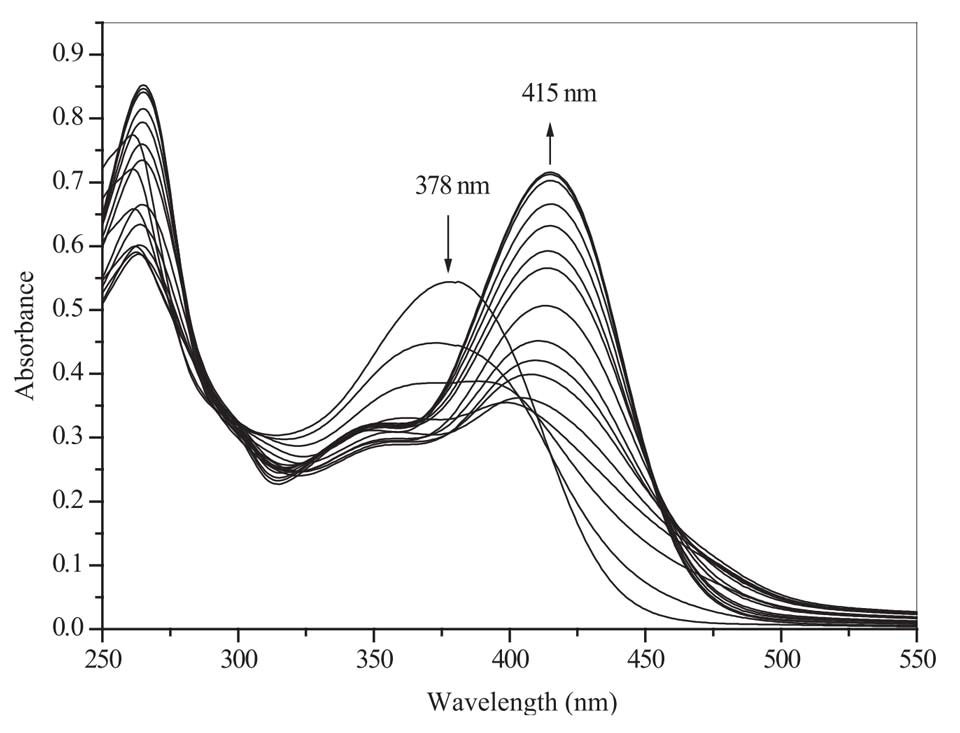
The visible spectrum of morin in aqueous solution, showing the bathochromic shift in light absorption as the alum concentration is increased from zero
(Septhum, Rattanaphani and Rattanaphani 2007, 93)
Like flavonols in general, morin forms stable complexes with metal cations in weakly acidic solution. In the case of aluminium it forms a complex that gives a deep yellow dye. With iron it produces an olive green; with beryllium a yellow-green. It also complexes with gallium, antimony, chrome, copper, tin, titanium, tungsten and zirconium (Burger 1973, 111; Malešev and Kuntić 2007; Starý 2013, 176).

Proposed structures of morin-aluminium complexes (Septhum, Rattanaphani and Rattanaphani 2007, 93)
Morin oxidises when exposed to light, but is only about one fourth as light-sensitive as turmeric, which will fade after 100 flashes from a xenon strobe light.
As mentioned above, morin is also the main pigment in old fustic or dyer’s mulberry, Maclura tinctoria, formerly Morus tinctoria, (Chlorophora tinctoria), which was once used to make a bright yellow dye tinged with orange (Adrosko 2012, 32). Fustic was introduced to Europe by the Spanish from the West Indies and Central America during the sixteenth century and was imported in quantity in the form of logs. It was later used to dye khaki. The wood was rasped or chipped into small fragments and ideally pre-moistened prior to dyeing. Alum was the normal mordant, sometimes in combination with cream of tartar.
Safflower or Kasumba
Safflower (Carthamus tinctorius L.) is an herbaceous, highly branched, thistle-like annual herb with yellow to red petals. It belongs to the family Asteraceae. The safflower is a warm temperature crop, originally endemic to Western Asia. It has since been cultivated over the greater parts of tropical Asia, Africa, Russia and China. The colour of the flower varies from whitish yellow to red orange, the most common being a deep yellow.
Safflower was known as qurtum or qurtam in the Arab-speaking world, kardi in Marathi and kussum in Hindi, and kasumba or kesumba in Malaysia and Indonesia. The latter is thought to have Sanskrit roots (Hitchcock 1991, 49).
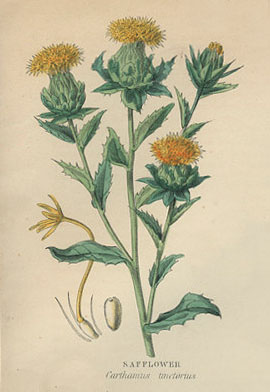
Safflower, Carthamus tinctorius (Walter Hood Fitch 1870)
Safflower flowers usually contain two pigments – the red carthamin, which is insoluble in water, and the yellow carthamidin, which is soluble in water. However yellow flowers contain little red pigment. An analysis of dried safflower flowers in China found that they contained 30% of the yellow pigment but only 2% of the red (Smith 1996, 50). Carthamin is the glucoside of carthamidin and can be hydrolysed into carthamidin and glucose.

The structure of carthamidin
In the past safflower was regarded as a good red dye but as a rather poor quality yellow dye. Safflower red was used in luxurious silk Persian carpets made around 1600 (Böhmer 2002, 124). Safflower yellow has been found on the linen wraps of Egyptian mummies dating from the twelfth dynasty, 1991-1803 BC (Barber 1991, 227).
To make the red dye the yellow pigment was first removed and discarded by rinsing the safflower petals in water until it ran clear. The red pigment was extracted into solution by the addition of a weak alkali such as ash water, which turned it colourless. The red returned when the solution was neutralised with citric or tartaric acid, just before the yarns were immersed in the bath (O’Neil and Fesquet 1869, 399-401). Safflower can produce attractive shades ranging from pink to poppy red. No mordant is required.
To make a yellow dye the flowers are collected in the early morning and the crushed petals are kneaded and stirred in cold water (Fraser-Lu 1988, 30). To improve fastness, the dye is always used with a mordant.
Safflower has been used throughout South Asia and Indonesia, although it is impossible to say how much it was used for yellow, rather than red. For example in the nineteenth century, safflower was used to produce a saffron colour on Sumatra (where it was called kasumba jawa) but a red dye on Java (Marsden 1811, 95; Crawfurd 1856, 135). In both India and Indonesia it was often used to dye silk.
Crawfurd noted that safflower was indigenous to Indonesia and found throughout the archipelago. He found that it was most successfully cultivated on Bali, but also grew ‘in considerable perfection’ in Makassar, Turatea, Sulawesi, and Bima (Crawfurd 1820, 111 and 461-463). Like Rouffaer, Bühler thought that safflower was used in Indonesia as a yellow dye before the adoption of turmeric (1948, 2489).
Safflower was certainly used on Bali in the distant past and was still being cultivated in the mountain regions up to the nineteenth century (Stuart-Fox 1993, 89). Kasumba appears in the inscription of Bwahan, dated 995, and in another at Sembiran dated 1016 (Hauser-Schäublin 2008, 78).
Safflower seems to have been a highly valued plant in the Sultanate of Bima (Crawfurd 1820, 461). Referred to as kassumba it seems to have been an important export product (Zollinger 1856, 265). Safflower was also used as an alternative to turmeric at Lamalera on Lembata to give a yellow with similar poor fastness (Barnes 1989, 15).
The major disadvantage of safflower as a dye is that it is very unstable to light and alkali (O’Neil and Fesquet 1869, 400). In the past its use as a yellow dye was avoided by European dye houses. Specialists do not recommend its use as either a red or a yellow dye (Böhmer 2002, 125).
Laban Bark
Laban or leban (Vitex pinnata, also known as Vitex pubescens) is a fast-growing understorey tree that normally reaches a height of 15m, but has a maximum height of 25m (de Kok 2008, 28). It grows in tropical lowland scrubby forest and is distributed from India to Indonesia, but is not found in New Guinea. It is especially common in Malaysia, Sumatra, Kalimantan and Sulawesi, but is also found throughout the Lesser Sunda Islands. It is known as kalapapa in Kalimantan and gulimpapa in Sulawesi (Hendrikus, Lemmens, Lemmens and Soerianegara 1995, 508). It is called pampa on Komodo Island and hiketaroe on Sumba Island (de Kok 2008, 29).
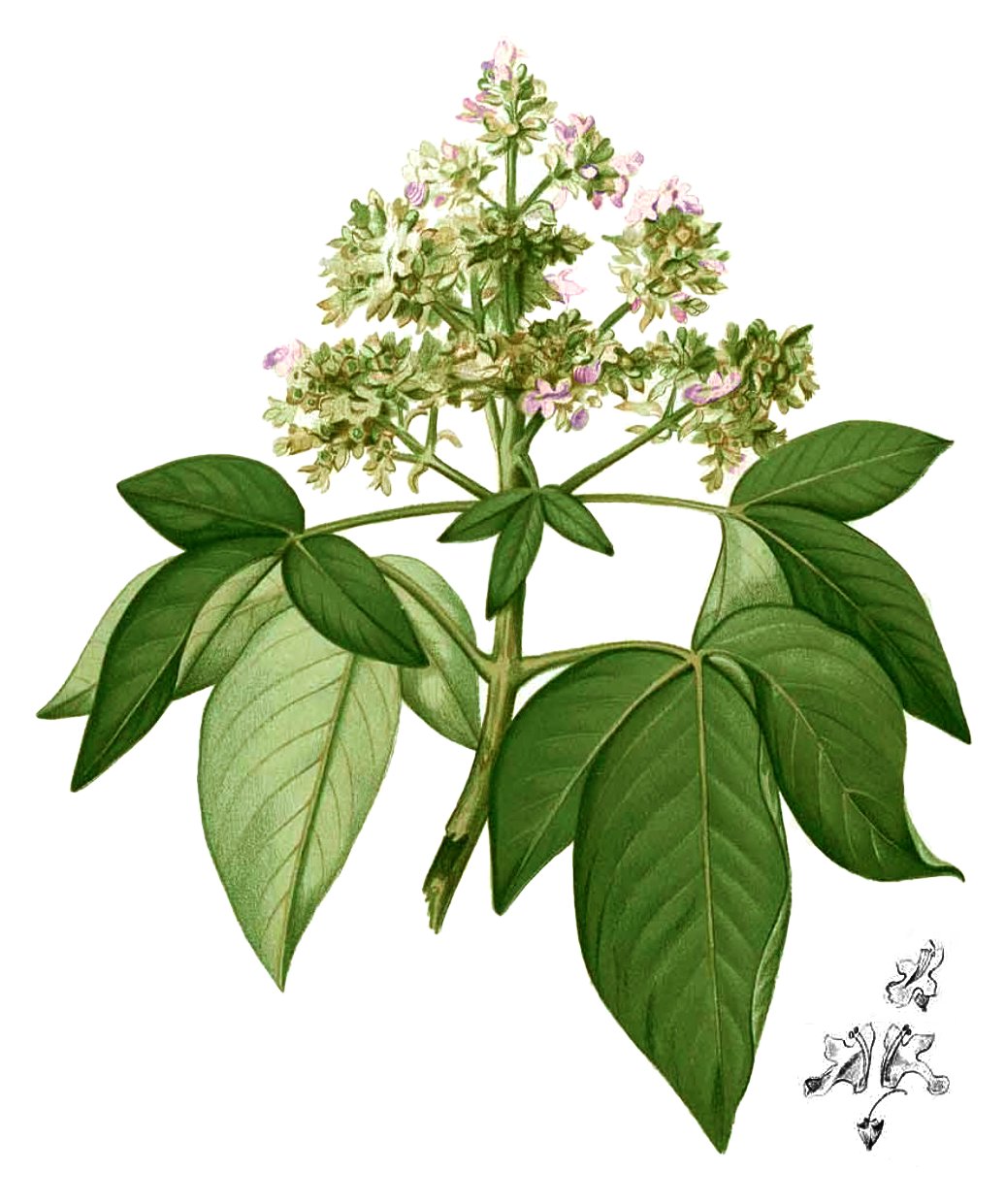
Vitex pinnata (Francisco Manuel Blanco 1880-1883, 427)
Laban produces a very hard wood that is ideal for construction and for making charcoal, and gives the tree considerable fire resistance. The bark of laban has been found to be rich in saponins, tannins and flavonoids (Adelina, Wardenaar and Sisillia 2014). In Banyumas, Central Java, the crushed bark was mixed with turmeric and the leaves of kara (Phaseolus vulgaris) to produce a yellow dye (Jasper and Pirngadie 1912, 62). In Soekanegara, West Java, the leaves were mordanted with copper sulphate to produce green (Jasper and Pirngadie 1912, 66).
In the early 1800s the laban tree was grown in Singapore and the neighbouring islands as a dye source for the Malays (Asiatic Journal, April 1825, 424). It apparently produced a lively and permanent yellow.
We have yet to find anyone in the Lesser Sunda Islands using laban as a dye today. However Ruth Barnes found one woman at Lamalera dyeing yellow with 'kajo kuma' , literally ‘yellow wood’, obtained from a hardwood tree that did not grow on Lembata but was imported from Adonara and Flores. The dye was obtained by soaking fine wood chips in cold water without the addition of lime. Several immersions were required to produce the right shade (Barnes 1989, 31). It is not clear whether this kajo kuma was laban or some other dyewood. We presume it was not kayu kuning since that author was already well aware that Cudriana was a widely used source of colourfast yellow in Indonesia (Barnes 1989, 15).
Prahout
Prahout or prahoot is a saffron-yellow coloured dye obtained from the bark and heartwood of the evergreen tree Garcinia vilersiana, which is closely related to the gamboge tree Garcinia hanburyi.
In Thailand the tree is known as maj prahoot and the dye is prepared by boiling the wood chips in water. It is used to dye silk. One dyer immersed her skeins of silk in a simmering dye bath containing the wood chips for two to three hours, after which the bath was removed from the heat and allowed to cool down with the silk still immersed. Another boiled the wood chips in water for four hours and removed the wood before adding the silk along with two types of tree leaf and boiling it again for an hour or so. After dyeing the silk was rinsed well and allowed to dry (Moeyes 1993, 26, 30-31).

Dried prahout bark, Cambodia
In Cambodia prahout (G. vilersiana) grows in the highlands. To make a yellow dye the bark is chopped into small pieces and boiled in water for half an hour. The resulting liquid is drawn off and mixed with powdered alum, the mordant changing its colour to light yellow (Sokny, Ratha and Vannak 2007, 22; Dupaigne 2004, 26). Some scholars of Cambodian textiles use the term bror hoot (Kikuo 2002).
In South Vietnam G. vilersiana is known as vang nhura.
Gamboge
The genus Garcinia encompasses over 200 species of large evergreen trees and shrubs, including the mangosteen, Garcinia mangostana (Osman and Milan 2006, 1). They are characterised by a straight trunk and a conical canopy. The Garcinia species are all pantropical with a range extending from India and Sri Lanka into south China, Southeast Asia (Burma, South Vietnam, Thailand, Cambodia and Malaysia), the Philippines and Indonesia (Osman and Milan 2006, 15-16). There are over 25 species from the Indian subcontinent, 23 species in Thailand and 20 in Indonesia. Garcinia especially thrives on Borneo.

The Indian Gamboge tree, Garcinia morella (Köhler 1890, vol. 2, t. 179)
Certain species of Garcinia tree are the source of gamboge, a bright golden-yellow pigment obtained by grinding down the hard brownish-red resin that is extracted in the form of a milky, light yellow latex from their trunks. The resin is tapped from cuts spiralling down the trunks and is collected in bamboo canes. The resulting tubes of solidified pigment were called pipe gamboge. It was also shipped in the form of cake or lump gamboge and coarse gamboge (Christison 1836, 233-2). The name gamboge is derived from Kamboja, an early name for Cambodia.
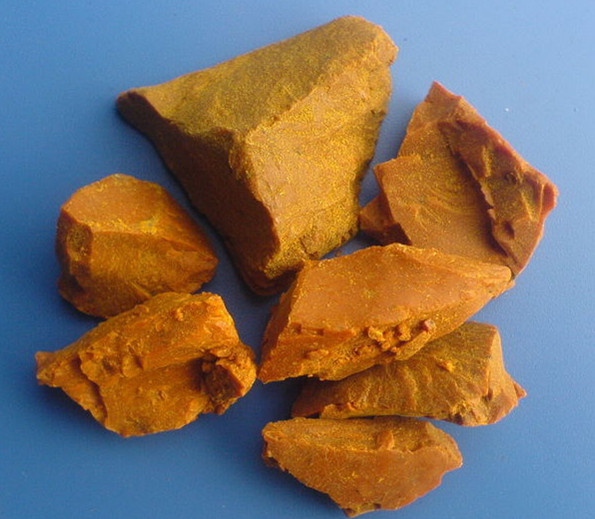
Gamboge resin from China
The main varieties harvested are Garcinia hanburyi, which grows in Cambodia and Thailand and produces Siam gamboge; G. morella and G. cambogia, which grow in India and Sri Lanka and produce Ceylon gamboge; and G. elliptica and G. heterandra, which are found in Burma (Eastaugh, Walsh, Chaplin and Sidall 2008, 170-171; Yaacob and Tindall 1995, 15). In southern India and Sri Lanka, Garcinia cambogia is known as the gamboge tree and is the source of an acidic fruit used as a substitute for tamarind and lime. The gamboge tree is known as rung in Cambodia, rong in Thailand and vang nghè or dang hoàng in Vietnam (Lemmens and Soetjipto 1991, 75). The French refer to it as guttier.
Gamboge resin is composed of 70-80% resin and 15-25% water-soluble gum. Chemically it is mainly composed of a wide range of yellow xanthone pigments, the most important being gambogic acid and gambogin (Asano et al 1995). It is soluble in water, alcohol and ether, forming an intense yellow solution that turns to red following the addition of a small quantity of alkali. It is primarily used as a pigment in the paint and lacquer industries.
It seems that gamboge was one of the many pigments traditionally used to dye the silk robes of Theravada Buddhist monks (Lewington 1990, 206-207; Cunningham 2014, 132). One report claims that the dye was obtained from G. tinctoria (Hanelt 2001, 1352). In Burma, gamboge only seems to have been used occasionally for dyeing monk’s robes (Mason 1860, 482). For example, the monks of Amarapura at Mandalay distinguished themselves by wearing brownish-yellow robes, dyed using a mixture of gamboge and sappan (Proceedings of the American Pharmaceutical Association 1885, 173). Gamboge was also used as a textile dye by the Burmese Karen (Mason 1860, 482). The sap of rong (claimed to be the mangosteen, Garcinia mangostana) was used as a yellow dye in Thailand (Conway 2002, 181). In Cambodia the bark of G. xanthochymus is used to dye silk (Phukon and Phukon 2003).
We can find no reports of gamboge being used as a dye in Indonesia.
Interestingly the fruit hulls of mangosteen (G. mangostana) are used to make a red dye for cotton and silk by villagers in Nakhon Si Thammarat, southern Thailand (Chairat, Bremner and Chantrapromma 2007). Latex tapped from the mangosteen tree contains the yellow xanthone pigment mangostin (NIIR Board of Consultants and Engineers 2005, 244). Another red dye was once made from the fruit of Asam gelugor (Garcinia atroviridis) by dyers on northeast Malaysia for use on silk (Fraser-Lu 1988, 30).
Bibliography of Yellow Dyes
Adeel, S.; Bhatti, I. A.; EL-Nagar, K.; Alam, M. M.; and Ali, N., 2011. Dyeing Of Cotton Fabric Using UV Irradiated Turmeric (Curcuma longa L.) as Natural Dye, Research Journal of Textile & Apparel, vol. 15, no. 2, pp. 71-76.
Aggarwal, B. B.; Sunderam, C.; Malani, N.; and Ichikawa, H., 2007. Curcumin: the Indian Solid Gold, Advances in Experimental Medical Biology, vol. 595, pp. 1-75, Springer.
Böhmer, Harold, 2002. Koekboya: Natural Dyes and Textiles, REMHÖB-Verlag, Ganderkesee.
Bruchman, M., 1813. Yellow Colour for Dyeing, Extracted from the Wood of the Mulberry Tree, The Belfast Monthly Magazine, vol. 11, no. 65, pp. 476-477.
Clark, Mathew, 2011. Handbook of Textile and Industrial Dyeing: Principles, Processes and Types of Dyes, Cambridge.
Cunningham, Anthony B.; Maduarta, I. Made; Howe, Jean; Ingram, W.; and Jansen, Steven, 2011. Hanging by a Thread: Natural Metallic Mordant Processes in Traditional Indonesian Textiles, Economic Botany, vol. XX, issue X, pp. 1–19.
Cunningham, Anthony B, et al, 2014. Plants as the Pivot: the Ethnobotany of Timorese Textiles, in Textiles of Timor, Fowler Museum, LA.
Faridah Hanum, I.; and Van der Maesen, L. J. G., (eds), 1997. PROSEA: Plant Resources of South-East Asia 11: Auxiliary Plants, pp. 156-163, Yayasan Obor, Bogor.
Fraser-Lu, Sylvia, 1988. Handwoven Textiles of South-East Asia, Oxford University Press.
Freeman, H. S., and Peters, A. T., 2000. Colorants for Non-Textile Applications, Elsevier, Amsterdam.
Gittinger, Mattiebelle, and Lefferts, H. Leedom, 1992. Textiles and the Tai Experience in Southeast Asia, Textile Museum, Washington D. C.
Hamilton, Roy W., 1994. 'Textile Technology', in Gift of the Cotton Maiden: textiles of Flores and the Solor Islands, Hamilton, Roy W., (ed.), pp. 58–77, Los Angeles.
Harborne, Jeffrey B.; Marby, Helga; and Marby, T. J., 2013. The Flavonoids, Springer.
Hasan, M. M.; Hossain, M. B.; Azim, A. Y. M. A.; Ghosh, N. C.; and Reza, M. S., 2014. Application of Purified Curcumin as Natural Dye on Cotton and Polyester, International Journal of Engineering & Technology, vol. 14, no. 5,
Janick, Jules, and Paul, Robert E., 2008. The Encyclopaedia of Fruit and Nuts, Cambridge University Press.
Jansen, P. C. M., and Cardon, D., (eds), 2005. PROTA: Plant Resources of Tropical Africa 3: Dyes and Tannins, pp. 88-99, PROTA Foundation, Wageningen.
Jasper, J. E., and Pirngadie, Mas, 1912. De Inlandsche Kunstnijverheid in Nederlands Indie - Deel II: De Weefkunst, Mouton, The Hague.
Kajitani, Nobuko, 1980. 'Traditional Dyes in Indonesia', in Indonesian Textiles: Irene Emery Roundtable on Museum Textiles 1979 Proceedings, Textile Museum, Washington, D.C.
Kikusawa, Ritsuko, and Reis, Lawrence, 2007. Proto who utilised turmeric, and how? in Language Description, History and Development: Linguistic Indulgence in Memory of Terry Crowley, Amsterdam.
Liles, J. N., 1990. The Art and Craft of Natural Dyeing: Traditional Recipes for Modern Use, University of Tennessee Press, Knoxville.
Litz, Richard E., 2009. The Mango: Botany, Production and Uses, CAB International, Wallingford.
M'Cann, Hugh W., 1883. Report on the Dyes and Tans of Bengal, Bengal Economic Museum, Calcutta.
Mohanty, B. C.; Chandramouli, K. V., and Nail, H. D., 1987. Natural Dyeing Processes of India, Calico Museum, Ahmedabad.
Prabhakaran Nair, K. P., 2013. The Agronomy and Economy of Turmeric and Ginger, Elsevier, London.
Prasad, S., and Aggarwal, B. B., 2011. Turmeric, the Golden Spice: From Traditional Medicine to Modern Medicine, in Herbal Medicine: Biomolecular and Clinical Aspects, Boca Raton.
Samata, Ashis Kumar; and Konar, Adwaita, 2011. Dyeing of Textiles with Natural Dyes, in Natural Dyes, InTech, Rijeka.
Samata, Ashis Kumar; and Agarwal, Priti, 2009. Application of natural dyes on textiles, Indian Journal of Fibre & Textile Research, vol. 34, pp. 384-399.
Subagiyo, Puji Yosep, 2007. Indonesian Natural Dyeing Recipes, Jakarta.
Septhum, C.; Rattanaphani, V.; and Rattanaphani, S., 2006. UV-Vis Spectroscopic Study of Natural Dyes with Alum as a Mordant, Suranee J. Sci. Technology, vol. 14, issue 1, pp. 91-97.
Umbreen, Saima; Ali, Shaukat; Hussain, Tanveer and Nawaz, Rakhshanda, 2008. Dyeing Properties of Natural Dyes Extracted from Turmeric and their Comparison with Reactive Dyeing, RJTA, vol. 12, no. 4, pp. 1-11.
Warming, Wanda; and Gaworski, Michael, 1981. The World of Indonesian Textiles, Serindia Publications, London.
Publication
This webpage was first published on 24th January 2016.